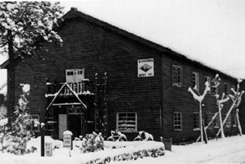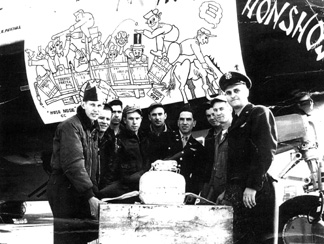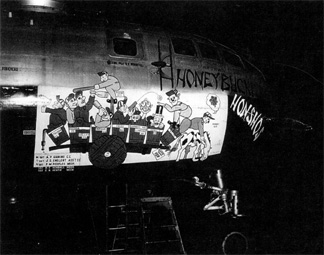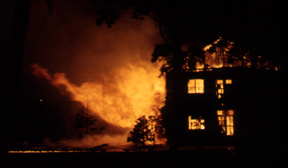|
Relating to The Earl E. Myers Story Chapter 20 |
|||||||||||||||
 |
|||||||||||||||
|
We arrived at Yokota on 29 June, 1950. We found our personal belongings had been packed and transported from Oki to Yokota by “who knows who,” and delivered to our assigned quarters. Our quarters were the same buildings that are illustrated in the crew history story by Chuck Stone in the chapter Settling In. We hit the ground running on arrival. In the early stages, we were moved over to Johnson AB, located adjacent to Yokota AB. The runway facilities at Johnson proved to be less than adequate and we were soon moved back over to Yokota. Before we were really settled in, we were flying combat recon missions. We did pre and post bomb damage assessment of dams, power plants, airfields, bridges and targets of military importance along the Yalu River and the entirety of North Korea. In the early stages, when our primary mission was accomplished, we would seek out targets of opportunity from the ground up.
|
|||||||||||||||
|
|
|||||||||||||||
 |
|||||||||||||||
|
Yokota AB |
|||||||||||||||
|
Editors Note There are extensive stories covering Earl Myers crew’s participation in From “Additional Korean War and early Cold War Classified Recollections by Earl E. Myers of the 31st and 91st SRS, Okinawa/Korea, 1950-51 Copy of Pacific Stars and Stripes article, Dec. 30, 1950, “Alone with the Enemy” Men share tales of reconnaissance missions: Story by James Kirley, Special Projects Writer, Vero Beach Press Journal — Recollections of Earl. E. Myers and Jack Romney Recollections of William F. (Bill) Welch of the 31st and 91st SRS From “Contributed Short Stories.” From: Earl E. Myers Time Frame — Early Korean War * On the Deck at Hamhung Harbor * Flashback - The Flower Sisters * Earthquake From: Bill Welch * Nose UP
From: Bill Sutton * Christmas and Valentines Day Air Drops
From: Earl E. Myers * THANKSGIVING DAY 1945 and 1950. World War II and KOREA
|
|||||||||||||||
| If you have become familiar with some of the stories outlined above, you will know that life for troops at Yokota was anything but dull. By August we noted nose art appearing on both the bombers and recon aircraft. Combat missions seems to cultivate the birthing process for nose art from as early as WW I. Our crew, considering the amount of ?crap? we had taken from our earlier squadron commander, chose the name “Honeybucket Honshos.” Our artistically inclined Navigator, Lt. Willie Wilson, drew the original picture that was approved for use by the entire crew. We then hired a Japanese artist, who worked on the base, to place the image on our assigned aircraft, under Willie’s supervision.
Two views of our nose art cartoon are shown on the right. Top right is the original presentation. The one on the right is a more complete version developed over time by the crew that was assigned to the aircraft after our return to the States. The AC of this crew was Jack Romney. By September, 1950, a number of our crews had one or more nerve-shattering experiences with the North Korean searchlights. Our penetration tactics included running with lights out as we moved in on our assigned targets. Our eyes would adapt to these conditions, permitting us full control of the aircraft using minimal crew position lighting. To be suddenly surrounded by the brilliant white lights from multiple radar-directed ground-based searchlights was disorienting to say the least. Especially knowing that we were suddenly sitting ducks for their increasingly sophisticated antiaircraft equipment. |
|||||||||||||||
 |
|||||||||||||||
|
Paskall, Radio; Stanley O. Beaton, Photo; Frezza, Photo; Irvin Brooks, Tail Gunner; Carl M. “Hootch” Bomgardner, Flight Engineer (and a damned good one); 1st Lt. William F. Wilson; M/Sgt Pfieffer, Radar Nav.; Johnson, Scanner; Earl E. Myers, Aircraft Commander. Missing, John Becker. |
|||||||||||||||
 |
|||||||||||||||
 |
|||||||||||||||
|
Photo Ctsy. Earl Myers |
|||||||||||||||
| Beginning around September, the process of painting the underside of both the B-29s and RB-29s was initiated. Our combat crews happily embraced every new action and/or operating procedure that increased the chances of our returning home from our assigned missions and eventually that final trip back to the good old USA.
Departing from Yokota Air Base Japan in November 1950, we were climbing to our cruise altitude of 27,000 ft on a northwesterly heading with climb power and a full load of 500 lb bombs, plus 50 cal. ammo. Our Honeybucket Honchos RB-29 started to descend even with the nose in a climb attitude and climb power. We were crossing the mountains to the Northwest of Tokyo on our way to Korea to look for targets of opportunity above the 38th Parallel. The aircraft continued descending until we were about 3000 ft above the snow covered mountains. The next move was full power and if that did not stop the decent we were alerted to bail out.To have bailed out would have been almost certain disaster for the entire crew in all that mountain snow and temperatures with virtually no way of safely returning. We finally stabilized and started to climb without adding more power. Our mission continued as we each wondered how the heavy hand of Mother Nature could strive to press us down into the mountain peaks and then choose to release us from her grip. We later learned that we had been impacted by what was becoming known as the “Mountain Wave”. Editor’s Note: Much has been learned about the “Mountain Wave” The thrills and spills of flying repeated reconnaissance missions over North Korea, with an occasional classified side trip to gain new perspectives of enemy capabilities, were complemented by the growing sense of family within our crew. By now we knew each other’s capabilities, strengths and weaknesses. Each crewmember’s contributions to mission accomplishment was like an added insurance policy for us all. There were, on occasion, heartwarming times when we took advantage of opportunities to go the extra mile in contributing to the morale and welfare of our troops on the ground. There had been occasions when we converted our RB-29 into a low-level killing machine, finding and strafing the enemy wherever we could find them. There were heart-rending times when we flew low over our troops as they retreated across the Chosen Reservoir, dragging the wounded and dead, and we found ourselves helpless to give a helping hand, other than passing on to our commanders what was really happening down there. Our most heartwarming experiences involved collecting, packaging and delivering gifts and supplies to our beleaguered front line troops along the Yalu River at Christmas time, 1950 and Valentines Day, 1951. Entering the combat zone, by air, taking the risks, doing the assigned mission, and then returning to warm and comforting surroundings at our home base made us feel very fortunate and, at the same time, somewhat guilty, knowing what was going on down on that ground called Korea, both North and South. As Thanksgiving time, 1951, approached, our tour was winding down and our thoughts turned increasingly towards our return to the USA. Our crew had completed 43 combat missions over North Korea, and a number of additional missions that involved classified intrusions into or close to hostile territory. Our crew felt a sense of pride and pleasure in knowing that through good solid teamwork, a sense of continuing adaptability, and a can-do attitude, we had measured up and would likely survive this RB-29 combat crew, trial-by-fire experience. End of Chapter 20 — Go to Chapter 21 Go to EEM Introduction —Chapter 1 — 2 — 3 — 4 — 5 — 6 — 7 — 8 |
|||||||||||||||